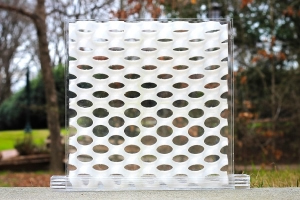
A research project to develop high-performance regenerative windows integrated with climate responsive solar cells will move to a new phase of development thanks to a $250,000 Partnerships for Innovation - Technology Translation (PFI-TT) grant from the National Science Foundation (NSF).
Principal Investigator Kyoung Hee Kim, associate professor of architecture, and her co-investigators Chengde Wu and Abasifreke (Aba) Ebong, will lead an interdisciplinary team that includes graduate and undergraduate student researchers and Dennis Richter, president of Richter Development and Solterra Partners.
“The proposed high-performance window system incorporates a closed air cavity where solar cells are suspended in a conditioned, closed air space to prevent heat build-up, dust accumulation and moisture formation resulting in high energy conversion efficiency and system longevity,” the team wrote in their project abstract.
The geometry of the solar cells is configured in response to a site-specific sun’s path to maximize energy production. And in addition to producing clean energy, the windows will have additional attributes, such as acoustic and thermal insulation, good shading capabilities, year-round daylight penetration, and view-out, while maintaining an aesthetic appeal.
NSF PFI-TT grants offer the opportunity to translate prior NSF-funded research results in any field of science or engineering into technological innovations with promising commercial potential and societal impact.
Kim’s solar window project project began in the School of Architecture’s Integrated Design Research Lab (IDRL) and was nurtured through the University’s Ventureprise entrepreneurship program. It received a 2020 NSF Innovation Corps (I-Corps) grant to promote net zero architecture practices by incorporating concentrated micro-photovoltaic cells within double pane glass.
Last summer, the team carried out a preliminary proof of concept, fabricating small-scale prototypes and conducting computer simulations and lab measurements. In this next year, they will further the proof of concept through prototyping and performance verifications in both the IDRL and Photovoltaic Research lab in EPIC, the Energy Production and Infrastructure Center in the William States Lee College of Engineering.